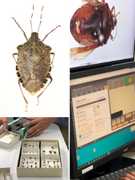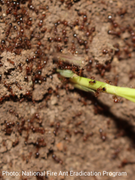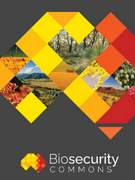Australia is home to a vast number of species, many of which occur nowhere else. Unfortunately, however, the high uniqueness of our plants and animals makes our ecosystems unusually vulnerable to invasive species. In this webinar, three presenters will talk about their efforts to predict, locate, and eradicate high-impact invasive species before they become established, a crucial step in protecting our precious ecosystems.
This webinar took place at 1.00pm AEST, Tuesday 24 May 2022, with 238 live viewers in attendance.
Speakers

Alexander Schmidt-Lebuhn | CSIRO
Alexander is a CSIRO scientist at the Australian National Herbarium in Canberra, where he leads the Plant Systematics and Population Genetics team. His research interests include phylogenetics, taxonomy, and biogeography in particular of Asteraceae (daisy family) and the application of computer vision to species identification and collection science. Alexander’s work mobilises collection specimens and their DNA and label data to understand the evolution of Australia’s biodiversity, to produce identification tools, and to support conservation, biosecurity, and biological control research.

Andrew Turley | QLD Department of Agriculture and Fisheries
Andrew leads the Strategy directorate for the National Red Imported Fire Ant Eradication Program, within the Queensland Department of Agriculture and Fisheries. Having joined the program in 2019, Andrew leads the development of program strategies, the implementation of its science, policy, systems and intelligence, and communications and engagement functions. Prior to joining the fire ant program, Andrew led Project DIG at the Queensland Museum Network, and multiple projects for the World Mosquito Program within Australia and abroad.

Paul Tudman | BioSecurity Commons
Set to launch in April 2023, Biosecurity Commons will deliver a cloud-based decision-support platform for modelling and analysing biosecurity risk and response. Paul is a data and analytics specialist with over 20 years of experience working on large-scale projects for state and federal governments, and academia. As the Project Manager for Biosecurity Commons, Paul is responsible for leading a highly-skilled team of software developers, scientists and communicators to build powerful decision-support tools for biosecurity using cloud-based technology.

Moderator bio
Erin Roger is the Biosecurity Lead for the Atlas of Living Australia. The program aims to strengthen biosecurity practices and partnerships for Australia, improving outcomes for our native species and industry. Erin is also the former Chair of the Australian Citizen Science Association. Prior to her work in these spaces, Erin worked in climate change adaptation and has a PhD in Terrestrial Ecology.
Q&A
We had so many wonderful questions. Please see below for answers to the questions we didn’t quite get to:
Q. Are there laws around the movement of dirt (fill) in fire ant areas? It is common practice in my area to seek fill. How do you discourage the community from seeking out fill and raise awareness around the risks associated with moving dirt?
A. Andrew Turley: Yes, there are restrictions on the movement of fire ant carriers regulated through the Biosecurity Act 2014. However, many materials can be moved safely if appropriate mitigation measures are taken. The National Fire Ant Eradication Program website is the best source of information about this. Restricting movement relies heavily on advertising, community engagement and cooperation, though we do have a compliance team that routinely checks businesses and respond to community reports of illegal movements too.
Q. Do events like flooding risk larger-scale movements of ants, or other species?
A. Andrew Turley: Yes. Fire ants originate from the Amazon floodplains, and whole colonies can form large rafts and float during flooding events (see this recent media article from The Guardian discussing this). In SEQ, we’re lucky that all fire ants are east of the great dividing range and the rivers/creeks flow eastward back into the infested area. As such, the impact of flooding on fire ant eradication efforts is minimal at this time.
Q. How do you deal with taxonomic inconsistency? For invasive species, the ALA, GBIF, and CABI are not consistent. Is there an expert input process?
A. Paul Tudman: The Biosecurity Commons platform will provide a suite of online tools for analysing data and provide easy access to online data repositories through a data catalogue. However, assessing the quality of the data that is used in any analysis will fall on the shoulders of the practitioner. We may investigate the challenge of taxonomic inconsistency between repositories in future versions of the platform but that is currently out of scope for the proof-of-concept stage of the project.
Want more?
All ALA webinars are available to view on our YouTube channel along with other video content.